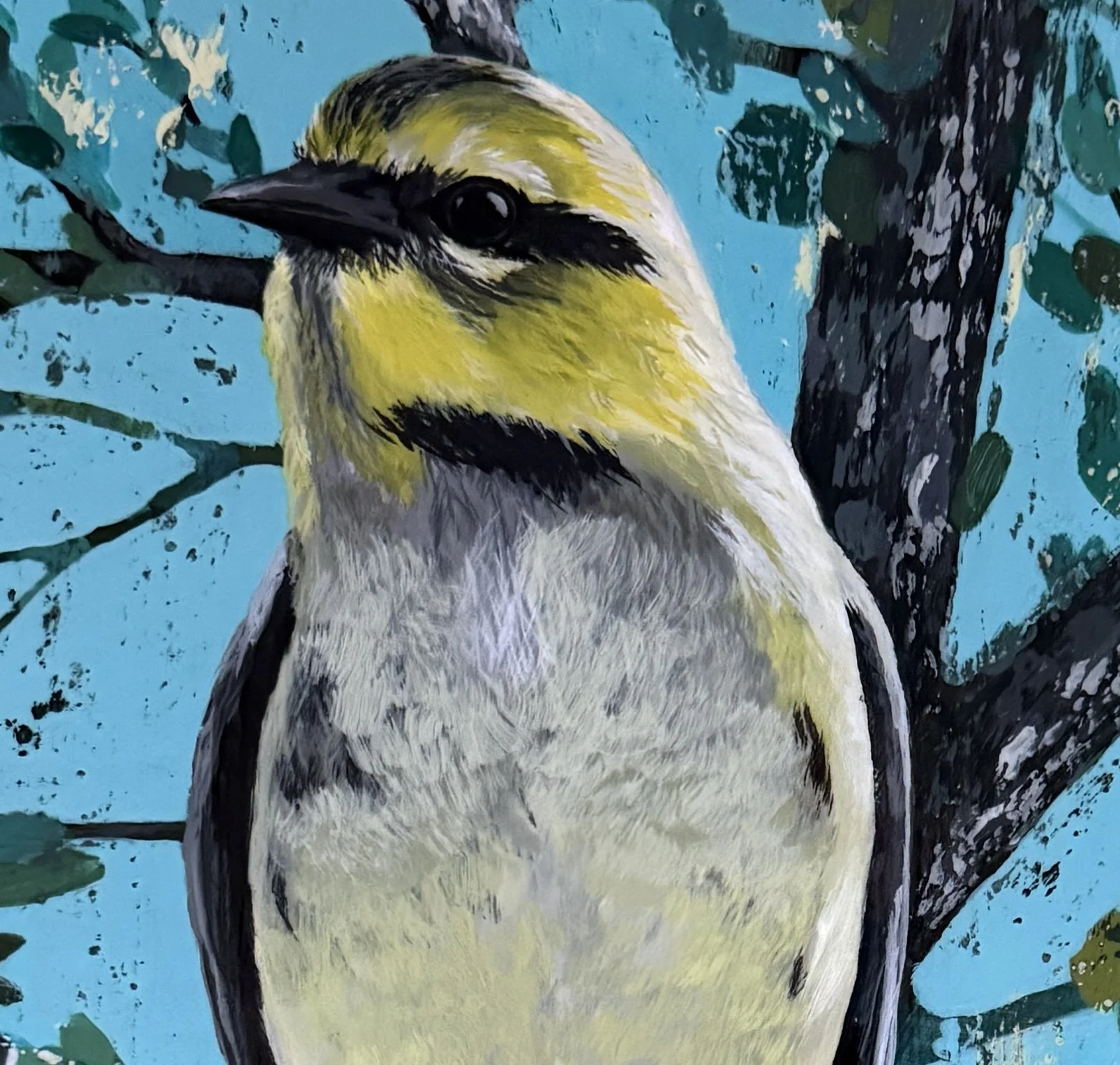The Golden-Cheeked Warbler: A Hill Country Treasure Worth Protecting
There’s something magical about spotting a Golden-cheeked Warbler. I don’t think I know many people who have actually seen these birds. This little bird, with its striking yellow cheeks and sweet song, is one of the Hill Country’s rarest and most captivating residents. You are much more likely to hear them than see them.
I was lucky enough to meet two of them on our property in Wimberley, Texas. They seemed just as curious about me as I was about them—flitting close and chirping as if to say, “What brings you to our woods?” That moment inspired one of the paintings in my current series and stands tribute to their beauty and to the wild spaces they depend on.
“Hill Country Observer” 12 x 12 Acrylic on panel
Here’s a little detail of my latest painting for my six-part series. This painting will be released for purchase soon. Join the Collector’s Circle to get up-to-date information on my latest releases.
Who Is the Golden-Cheeked Warbler?
The Golden-cheeked Warbler (Setophaga chrysoparia) is a small migratory songbird that breeds only in Central Texas—nowhere else on Earth. With its vivid yellow face and black mask, it’s unmistakable against the soft greens of the Hill Country canopy.
These birds have very specific nesting needs. They rely on the bark of mature Ashe juniper (commonly called cedar), combined with moss and spider silk, to weave their delicate nests. Without those older junipers, the warblers simply can’t raise their young.
Migration: Where They Go When They Leave Texas
Though they’re Hill Country icons, Golden-cheeked Warblers don’t live here year-round. They’re Nearctic-Neotropical migrants, meaning they breed in Texas each spring and summer, then migrate south to winter in Mexico and Central America.
They typically arrive in Texas between late January and March, and head south again by late July or August once nesting is complete. During the winter, they inhabit high-elevation oak-pine forests across southern Mexico, Guatemala, Honduras, El Salvador, and Nicaragua, where cooler mountain climates mimic their breeding habitat (USDA Forest Service; BirdLife International).
Their migration route likely follows the Sierra Madre Oriental mountain corridor through Mexico—a long but essential journey connecting two worlds (Ecological Society of America; USGS).
Because the warbler depends on both healthy Texas woodlands and intact Central American forests, conservation must protect its entire annual cycle.
Why the Warbler Is Endangered
The Golden-cheeked Warbler has been listed as endangered since 1990 due to widespread habitat loss and fragmentation. As development expands across the Hill Country, many of the mature juniper-oak forests these birds need are disappearing.
Other pressures—like invasive plants, climate change, and human disturbance during nesting—further threaten their survival (Texas Parks & Wildlife Department).
Yet, hope remains. Conservation efforts across Texas are restoring habitat and protecting large tracts of land, from preserves near Austin to private ranches in the Hill Country. Every tree left standing makes a difference.
How You Can Help
You don’t have to be a scientist to make an impact. Here are some simple, powerful ways to help:
Preserve native trees. Leave mature Ashe junipers and oaks on your property—they’re vital for nesting.
Support conservation. Donate to or volunteer with Hill Country Conservancy, Travis Audubon Society, or Texas Parks & Wildlife.
Share and educate. Use your social media, photography, or art to raise awareness about Texas wildlife.
Be a mindful observer. If you’re birdwatching, keep your distance, stay on marked trails, and skip the recorded bird calls during nesting season.
Art as a Form of Conservation
For me, art is a bridge between appreciation and action. My painting of the Golden-cheeked Warbler captures not just a bird, but a fleeting moment of connection—a small reminder of how deeply our lives are tied to the natural world. These little birds seemed so sweet and curious. I imagine it must be these two I hear calling when I’m in Wimberley.
It is my sincerest hope that my paintings serve as a call to protect what remains, so that future generations can look up into the same Hill Country trees and hear that sweet warbler song.
References
BirdLife International. (2020). Setophaga chrysoparia (Golden-cheeked Warbler) Factsheet. BirdLife DataZone.
https://datazone.birdlife.org/species/factsheet/golden-cheeked-warbler-setophaga-chrysoparia
Cornell Lab of Ornithology. (n.d.). Golden-cheeked Warbler overview. All About Birds.
https://www.allaboutbirds.org/guide/Golden-cheeked_Warbler/overview
Defenders of Wildlife. (2025, July). Golden-cheeked Warbler timeline.
https://defenders.org/sites/default/files/2025-07/GCWA%20Timeline.pdf
Ecological Society of America. (2019). Migration pathway analysis for Neotropical warblers. Ecosphere.
https://ecosphere-documents-production-public.s3.amazonaws.com/sams/public_docs/species_nonpublish/21297.pdf
Texas Parks and Wildlife Department. (n.d.). Golden-cheeked Warbler species profile.
https://tpwd.texas.gov/publications/pwdpubs/media/pwd_bk_w7000_0013_golden_cheeked_warbler.pdf
U.S. Fish & Wildlife Service. (2024, May). Continental conservation for the Golden-cheeked Warbler.
https://www.fws.gov/story/2024-05/conti?nental-conservation-golden-cheeked-warbler
U.S. Fish & Wildlife Service. (n.d.). Golden-cheeked Warbler (Dendroica/Setophaga chrysoparia) species profile.
https://www.fws.gov/species/golden-cheeked-warbler-dendroica-chrysoparia
U.S. Geological Survey. (2017). Golden-cheeked Warbler population dynamics and habitat conservation. USGS Publications Warehouse.
https://pubs.usgs.gov/publication/70177144
U.S. Forest Service. (2023). Annual-cycle connectivity for the Golden-cheeked Warbler (Setophaga chrysoparia). Northern Research Station.
https://www.fs.usda.gov/nrs/pubs/jrnl/2023/nrs_2023_reidy_001.pdf
*A Note on How This Post Was Made
I sometimes team up with AI tools to help shape my blog posts—kind of like having a brainstorming buddy who never runs out of ideas. I always review, edit, and add my own touch, so everything you read here still comes straight from my love of art, nature, and birds.

